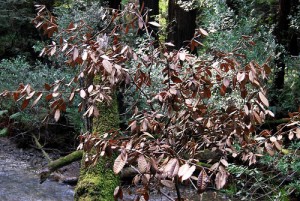
The U.S. Forest Service says hundreds of thousands of oak trees have died over the last year due to the plant disease known as Sudden Oak Death. Scientists still don’t have a reliable way to control the epidemic.
The spike in tree deaths, more than 300,000 in California this past year, is due to the wet spring and dry summer – ideal conditions for Sudden Oak Death to spread. The disease is appearing in new areas, including the East Bay, Big Sur and Mendocino.
Susan Frankel of the U.S. Forest Service says they expect it to get worse in years ahead. “Our models and observations predict that millions and millions and millions of tan oaks will die over the next 30 to 40 years,” she says.
“The frustrating thing is that this is an invasive pathogen,” she says. It was introduced to the Bay Area 15 years ago through nursery plants. The spores are spread by native bay laurel trees, as well as rhododendrons, camellias and other ornamental trees.
The widespread impact of the disease is easy to see in Marin County. “Around Mt. Tamalpais, we’ve had an entire change of the ecology,” says Frankel. “The tan oak used to be the dominant species there and now it’s at a low level. All the wildlife that feeds on acorns has to find other food sources.” Dead trees also pose a fire risk.